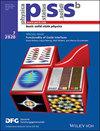在应变松弛分布式布拉格反射器缓冲层上生长氮化铝镓的金属有机化学气相沉积技术
IF 1.8
4区 物理与天体物理
Q3 PHYSICS, CONDENSED MATTER
引用次数: 0
摘要
本文研究了在 AlN/Al2O3 模板上通过金属有机化学气相沉积生长的 AlGaN 分布布拉格反射器 (DBR) 的应变松弛、表面形貌和反射率。10 周期的 Al0.50Ga0.50N (27 nm)/Al0.75Ga0.25N (29 nm) DBR 开始出现应变松弛,应变松弛程度(DSR)随 DBR 周期数的增加而增加。30 期 DBR 在 279 纳米波长处的峰值反射率为 0.82,止带为 12 纳米。随着 n-Al0.62Ga0.38N 厚度从 0.4 μm 增加到 2.5 μm,30 期 DBR 上 n-Al0.62Ga0.38N 的 DSR 从 70% 增加到 100%。虽然 DBR 表面由许多螺旋丘组成,但在氮化铝 DBR 上生长的 n-Al0.62Ga0.38N 却呈现出阶梯式流动生长。在 30 周期 AlGaN DBR 上生长的 2.5 μm 厚 n-Al0.62Ga0.38N 的 DSR 为 100%,螺纹螺旋位错为 2.0 × 108 cm-2,螺纹边缘位错为 1.2 × 109 cm-2。本文章由计算机程序翻译,如有差异,请以英文原文为准。
Metal–Organic Chemical Vapor Deposition of n‐AlGaN Grown on Strain‐Relaxed Distributed Bragg Reflector Buffer Layers
The strain relaxation, surface morphology, and reflectivity of AlGaN‐distributed Bragg reflectors (DBRs) grown via metal–organic chemical vapor deposition on AlN/Al2 O3 templates are investigated. Strain relaxation begins in a 10‐period Al0.50 Ga0.50 N (27 nm)/Al0.75 Ga0.25 N (29 nm) DBR, and the degree of strain relaxation (DSR) increases with the number of DBR periods. The 30‐period DBR exhibits a peak reflectivity of 0.82 at 279 nm, with a stopband of 12 nm. The DSR of n ‐Al0.62 Ga0.38 N on the 30‐period DBR increases from 70% to 100% as the n ‐Al0.62 Ga0.38 N thickness increases from 0.4 to 2.5 μm. Although the surface of a DBR comprises numerous spiral hillocks, n ‐Al0.62 Ga0.38 N grown on an AlGaN DBR exhibits a step‐flow growth. A DSR of 100% with threading screw dislocations of 2.0 × 108 cm−2 and threading edge dislocations of 1.2 × 109 cm−2 is obtained for a 2.5 μm‐thick n ‐Al0.62 Ga0.38 N on a 30‐period AlGaN DBR.
求助全文
通过发布文献求助,成功后即可免费获取论文全文。
去求助
来源期刊
CiteScore
3.30
自引率
6.20%
发文量
321
审稿时长
2 months
期刊介绍:
physica status solidi is devoted to the thorough peer review and the rapid publication of new and important results in all fields of solid state and materials physics, from basic science to applications and devices. Being among the largest and most important international publications, the pss journals publish review articles, letters and original work as well as special issues and conference contributions.
physica status solidi b – basic solid state physics is devoted to topics such as theoretical and experimental investigations of the atomistic and electronic structure of solids in general, phase transitions, electronic and optical properties of low-dimensional, nano-scale, strongly correlated, or disordered systems, superconductivity, magnetism, ferroelectricity etc.

 求助内容:
求助内容: 应助结果提醒方式:
应助结果提醒方式:


